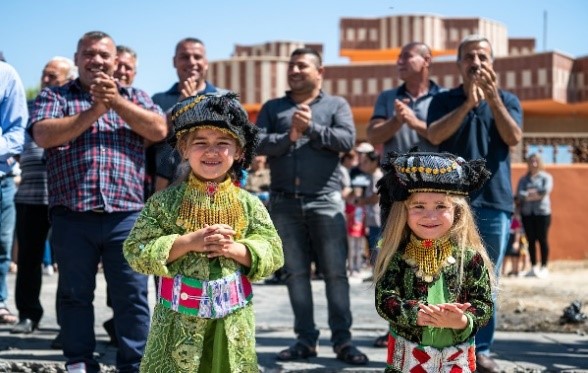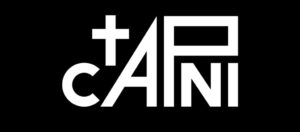About Batnaya
Batnaya (ܒܛܢܝܐ in Syriac, باطنايا in Arabic) is an ancient Christian township in the Nineveh Plain NP. It is located 22 kilometers north of Mosul and 6 kilometers north of Telkeif on the road linking Mosul and Alqosh through Telkeif. The inhabitants of Batnaya are all Christian believers of the Chaldean Catholic Church and speak Eastern Syriac (Surith) as the mother tongue. Batnaya is under the jurisdiction of the Chaldean Diocese of Alqosh.
Less than 15 Arab families lived there before ISIS invaded Batnaya on 6th August 2014, when all Batnaya families fled seeking safety and security in Dohuk and Erbil.
Batnaya coordinates: 36°32′15″N 43°7′24″E
The Name Origin
Batnaya is first attested with the name Beṯ Maḏāye in the History of Beṯ Qōqā in the seventh century AD, at which time the village is believed to have been converted to Christianity by Mar Oraha (Saint Abraham the Mede).
The village’s original name, Beṯ Maḏāye, is argued by the French scholar Jean Maurice Fiey to derive from “beth” (“place” in Syriac) and “Madaye” (Medes) and thus translates to “place of the Medes”.
He also argues that the name Beṯ Maḏāye suggests that the village was inhabited by Yazidis prior to their conversion.
Batnaya is also identified as the Beṯ Maḏāye mentioned in a letter of Catholicos Ishoyahb II (r. 628–645).
There is no historical source that explains the meaning of Batnaya name, source or initiating date.
Several theories have been put forward for the origin of the name of the village as local traditions suggest it may derive from “beth” and “ṭeṭnāyé” (“clouded corneas” in Syriac), thus translating to “the place of those who have clouded corneas”, which is believed to allude to eye diseases caused by plaiting reeds.
Others suggest it is as a linguistic modification of the Syriac name (Beit Tina), i.e. the house of clay, relative to the building material used in the past in the construction there and the abundance of good soil, there are others who see it as a linguistic modification of the Syriac name (Beit Tanana), i.e. the house of zeal, which is characteristic of Batnaya society.
Brief History
As its name, and as many towns and villages in the Nineveh Plain there is no historical source documenting when and how Batnaya was founded.
But it certainly dates back to the 6th century AD and before it, where it received the monk Oraha (Abraham), who settled there at the beginning of the seventh century (circa 612), and is believed to have preached Christianity to Batnaya inhabitants and founded the nearby monastery, which bore his name: the Monastery of Mar (St.) Oraha.
The village was populated by Assyrians, all of whom were adherents of the Church of the East until a number of people adopted Catholicism at some point in the early 18th century before 1729.
The village and its church were plundered by the forces of Shahanshah Nader Shah in 1743 amidst the Ottoman–Persian War of 1743–1746 and the church was restored in the following year.
By 1767, the village’s entire population of 200 families had joined the Chaldean Catholic Church.
When visited by the English missionary George Percy Badger in 1852, 60 families resided at Batnaya and William Francis Ainsworth counted 50 houses in the village in 1857.
The population grew to 900 people by 1867 and then to 1000 people in 1891.
In 1913, Batnaya was inhabited by 2,500 Chaldean Catholics with three priests. The church of Mar Quryaqos was rebuilt in 1944.
By 1961, the population of Batnaya had reached 3104 people. According to 1997 census, Batnaya inhabitants were 3331.
After 2003, the number was almost doubled as dozens of Christian families (Batnaya and other origins) fled Iraqi central and southern cities seeking safety in Nineveh Plains which was under security control of Iraqi Kurdistan Government.
In summer 2014 before ISIS invasion Batnaya inhabitants were more than 6000.
Batnaya Before ISIS
Batnaya has lived through centuries of stability and peace, as have the rest of the Nineveh Plain, where it has never been displaced or subjected to violent campaigns and attacks before ISIS on 6th August 2014.
Even the policies of Arabization and demographic change by all means exercised by the former regime against Christian cities in the Nineveh Plain had not begun in Batnaya.
Batnaya, like the rest of the Nineveh Plain, despite being under the Federal (central) government jurisdiction, was under the security control of Kurdistan regional government, making it a safe haven free of attacks, bombings, terrorism and organized crime that prevailed in the rest of Iraq and targeted mainly non-Muslim minorities, Christians, Yazidis and Mandaeans.
As a result of this safety in the Nineveh Plain, all its cities, including Batnaya, have hosted hundreds of Christian families displaced from various Iraqi cities (Mosul, Baghdad, Basra, etc.).
While this has helped protecting the lives of displaced people on the one hand, and many have contributed to the revitalization of economic life in the Nineveh Plain on the other, they have at the same time placed an additional burden on infrastructure, services and basic facilities, especially since these structures were weak in themselves because of the former regime’s policies of marginalization towards non-Arab and non-Islamic regions and communities.
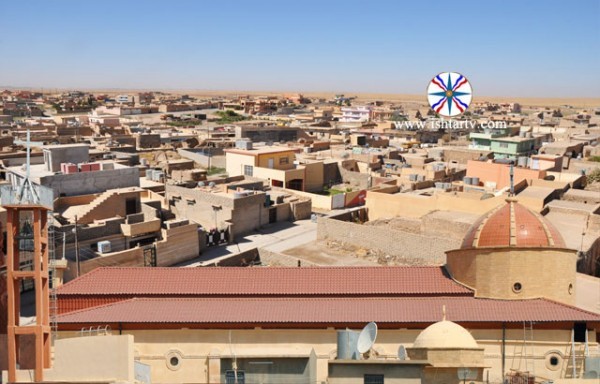
Public Services
Before ISIS, Batnaya had a number of government service institutions as below:
Schools
Before ISIS, Batnaya had:
- A kindergarten run by the Dominican sisters, and another unfinished government kindergarten.
- Two primary schools, one for males and one for females.
- One mixed secondary school (intermediate and high school).
Graduates of the high school (Abitur) were attending Mosul University for the academic university studies.
Health Services
Batnaya had a primary health care center that provided simple basic treatment services during official working hours, while the nearest clinic was in Telkeif.
For specialized or in-hospital treatment, Mosul doctors and hospitals were the closest.
Livelihood And Resources
Like the rest of the townships and cities in the Nineveh Plain, where the region is economically marginalized and not included in government economic development plans and the non-establishment of production plants and other activities, the economic resources of the Batnaya community were limited.
Employment in the public sector and government departments (Schools, Health, Municipality, etc.) in Batnaya, Telkeif and Mosul was one of these resources.
The private sector has been limited to limited-service activities of limited size and number, such as small markets, barber shops, butcher, carpentry, electrical installations and others, for which the economic market has remained limited in Batnaya and has not been able to attract customers from outside Batnaya because of its inability to compete with the similar but larger markets and services in the nearby towns of Telkeif and Telesquf.
The limited private sector has led many young people and families from Batnaya to move and settle in large cities inside Iraq, such as Mosul, Baghdad, Basra, Erbil, etc., in search of work and improving the family’s standard of living, many of whom have succeeded in establishing and developing their own economic activities in industry, trade, and hotels and restaurants.
Rainwater-based agriculture, particularly wheat cultivation, has been a traditional economic activity for Batnaya families, who own large tracts of land suitable for this type of agriculture. But productivity has declined significantly in the last decade due to climate changes that have led to a drop in rainfall.
Community Spaces
Although Batnaya is relatively limited in terms of the number of families compared to Telkeif, Telesquf and Alqosh, as well as its proximity to the city of Telkeif, the capital of the District of Telkeif, Batnaya has had good sports and community activities.
Since 2006, with the financial support of the Kurdistan regional government, Batnaya sports club has been established a small but suitable open court has been installed.
Community space was also available in a park inside Batnaya, frequented by families for good community times as well as popular celebrations.
Batnaya also had a small, suitable hall used for weddings and condolences.
In addition to a number of cafés that young people used to visit, especially in the evenings.
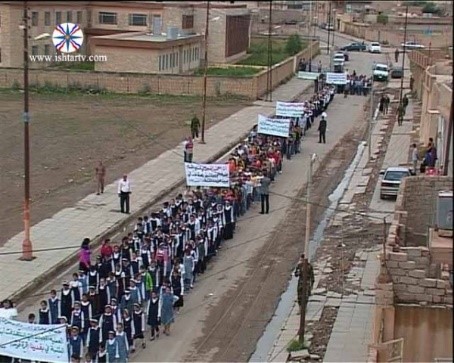
Churches
Batnaya, like various Christian townships and villages in Iraq, has more than one church, one of which is the large church dedicated to the patron saint of the village and the rest of the churches are small churches or shrines.
The patron saint of Batnaya is Mar (St. in Syriac) Quryaqos the martyr, where the big church bears his name and is in the middle of Batnaya on a slightly high position. It is a large church with a magnificent design from within, with alabaster columns as well as the sacred altar.
The church of Mar Quryaqos, which is believed to have originally been a monastery, is mentioned in 1474, in which year a manuscript was copied there by the priest Īshō, son of Isaac, of Hakkari.
Its last renovation before ISIS was in 1944, and was rehabilitated three years ago, where it was harmed and maimed during the occupation of ISIS.
The commemoration of St. Quryaqos is on the 15th of July of each year, where the divine mass is held by the diocesan Bishop of Alqosh and with the broad participation of the community living there and the scattered in the different places of Iraq as well as many families coming from the diaspora for this occasion, as well as the participation of families from nearby towns and villages such as Telkeif, Telesquf, Alqosh and others.
After the Divine Mass, the people gather in the open space near the church where they keep celebrating the day, dancing folk dances and singing till the sunset.
In addition to the Church of St. Quryaqos, there is the Church of Mart Maryam (Virgin Mary and in Arabic: al-Tahira, “all pure”) which was constructed in 1866 next to St. Quryaqos church.
There is also the Monastery of St. Joseph which is a large house inhabited by Dominican nuns before ISIS, which also has rooms and halls for Christian education and kindergarten for the education of children.
Batnaya has a shrine dedicated to Mart (St.) Shmony (Female Saint from Maccabees B.C.) where Batnaya graveyards are centered and visited by people on Mart Shmony commemoration in May each year to perform prayers.
Near Batnaya, the Monastery of Mar Oraha (St. Abraham) is located about one kilometer from the east, where the community and nearby villages visit it annually on Mar Oraha commemoration day, the second Sunday after Easter.
In 2008, the Kurdistan Regional Government renovated the monastery and built more than 25 houses where a number of villagers lived.
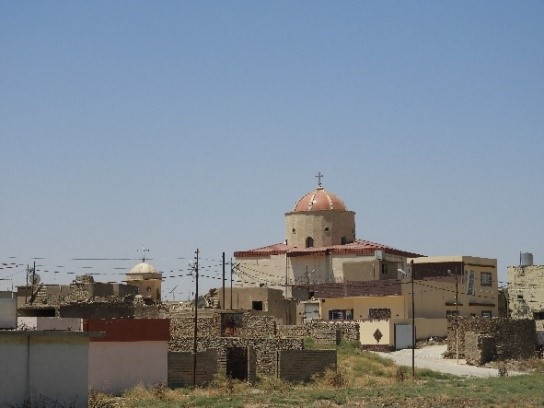
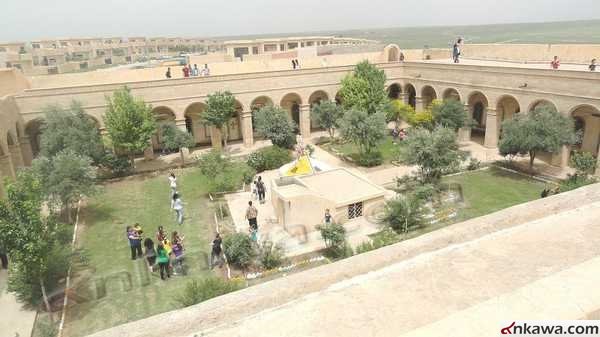
Prominent from Batnaya
Bishop Mar Shlemon Warduni A Chaldean Catholic Bishop born at Batnaya, on April 24, 1943, and was ordained priest on June 1968. On January 12, 2001, he was appointed Auxiliary Bishop of the Chaldean Patriarchate and he was consecrated bishop on February 2001, by Patriarch Mar Raphael Bidawid.
After the passing of Patriarch Mar Raphael Bidawid, Bishop Warduni fulfilled the patriarchal duties (Locum tenens) till Patriarch Mar Emanuel Delli was elected on December 2003.
Bishop Warduni was appointed by the Chaldean church as the president of Caritas – Iraq.
Batnaya Diaspora
Immigration to USA, Europe and Australia for various reasons, including economic, has also covered Batnaya, as have all Christian community in the different Iraqi regions, cities and villages, and the number of immigrant families has escalated after the end of the Iran-Iraq war in 1988, increasing further after the 2003 war and increase again after the occupation of ISIS. The Batnaya diaspora is particularly concentrated in America.
CAPNI and Batnaya
With the toppling of the former regime in 2003, CAPNI had the opportunity to expand the geography of its then-confined work in Dohuk province to include the Nineveh Plain, which includes an important Christian demographic and has suffered for decades from economic and service marginalization from all Iraqi regimes.
The fall of the regime went beyond the fall of the ruling group to the collapse of the Iraqi state with all its organs, including security, military, judicial, service and others, which soon created a vacuum filled by the forces of fait accompli, especially the parties and forces that owned the militia and extremist fundamentalist ideology that practiced systematic terrorism directed at non-Muslim minorities, Christians, Yazidis and Mandaeans, who became the easy target of these forces, and became the soft target of organized crime gangs that practiced threats and kidnapping to blackmail money from Christian families in various cities and regions of Iraq that were under the former regime before it was overthrown.
This has led to thousands of families migrating from these areas to Kurdistan and the Nineveh Plain, which was under security control of Kurdistan government.
This was an additional reason for CAPNI to switch its targeting area from Dohuk to the Nineveh Plain to serve displaced people in various service, health, education and other programs.
Batnaya has had its share in hosting displaced families, many of whom are originally from Batnaya who have left earlier for Iraqi cities in search of a better life.
Batnaya had its share in CAPNI programs. Indeed, CAPNI was almost the only acting NGO who had sustainable presence and activities in Batnaya after 2003.
Below are some of the programs carried out by CAPNI in Batnaya from 2003 to summer 2014 before the occupation of ISIS:
- Continued distributions of food and hygiene baskets for new displaced persons and needy families
- The establishment of the Student Service Center in Batnaya, which was a suitable space for students to meet to strengthen their study knowledge through its free services of copying and printing, internet service, library and others
In addition to its continuous organization of catch-up courses for formal schools’ subjects, especially for graduating classes (Abitur) to improve their graduation exams marks.
- Vocational trainings to develop the skills of young people in various fields according to the need of the market and for the purpose of providing them with jobs.
- Provide small grants or loans to young people and women headed families to start their own businesses.
- Support farmers with seeds and agricultural fertilizers.
- Awareness and therapeutic health services through courses and lectures as well as regular visits of CAPNI mobile clinic.
- Support for the Church’s pastoral programs: catechesis, Bible study, Syriac language, awareness and guidance lectures on various subjects.
- Construction of eight apartments for free housing of displaced families.
We seize the opportunity to extend our profound gratitude to the partners who were generous to support these projects: Evangelical Lutheran Churches in Bavaria and Wuerttemberg, Caritas, Barnabas Fund, and others.
Batnaya under ISIS
14th June 2014 ISIS occupies the over million-strong city of Mosul and Iraq’s second largest city.
The options available to Christians who were then living in Mosul were either Islam, jizya, murder or fleeing.
Thus, the Christians of Mosul were forced to leave their historic city, roots, churches and all their assets and belongings and fled in search of live saving, safety and security.
This is the first time in Mosul’s history that it has happened or that its Christian people have left it.
This is the first time in history that the bells of Mosul’s churches have been silenced.
Escape to where?
The Kurdistan Region and the Nineveh Plain (which was under the security administration of the Kurdistan Region) were the places where Christian families fleeing Mosul sought refuge.
Batnaya had its share of hosting large numbers of these families.
But, did the chapters of the story end there?
On 3rd August, ISIS terrorists headed to the Sinjar area, where the peaceful Yazidi community has lived for centuries.
ISIS has committed the most egregious genocide against the Yazidis: thousands have been killed and many of them are buried alive in mass graves, thousands more women have been taken and enslaved for sexual slavery, children have been taken to be raised as soldiers of the Islamic caliphate.
In addition to the destruction of all that ISIS could destroy in the Sinjar area.
Hundreds of thousands of Yazidis fled naked barefoot and on foot towards Mount Sinjar and from there to Dohuk province.
It was the tragedy of the times, and a stain on the history of inhumanity.
It was the alarm bell for what was coming to happen in the Nineveh Plains.
The alarm bell gave the Nineveh Plain residents Christians, Yazidis, Shiites Shabaks and others a 72-hour chance to escape before ISIS headed to occupy the Nineveh Plains on the night of 6/7 August.
It is a painful coincidence that this happened on the same date as the first genocide in Iraq’s modern history when the Semele massacre was committed on 7th August 1933 against Assyrian Christians.
With ISIS’s occupation of the Nineveh Plain, all its inhabitants, except for Sunni communities that hosted and coexisted with ISIS in Telkeif, Nimrod and elsewhere, fled to the Kurdistan Region, and other hundreds of families left the country to neighboring countries in Jordan and Turkey.
Nineveh Plains became a ghost area.
The geographic borders of ISIS’s occupation of the Nineveh Plain stopped towards Erbil at the Khazir River, and towards Alqosh stopped between Batnaya and Telesquf.
Batnaya thus became the only city that remained on the front, as it turned into an ISIS military base from which they bombard the positions of the Peshmerga forces, and in return they were bombarded by the Peshmerga forces and the international coalition.
This led to the widespread destruction of Batnaya, where the rate of destruction reached more than 70%.
ISIs fighters had inflicted significant damage to the village as the church of Mart Maryam, which had been used as a weapons dump, was blown up whilst the church of Mar Quryaqos was ransacked, and only 1% of the village’s 997 houses was still intact.
Much of the devastation happened during the day-long Battle of Batnaya – between ISIS and the Peshmerga, backed by the Iraqis – and the terror group enacted a policy of scorched earth before retreating to Mosul, the self-proclaimed capital of its so-called Caliphate.
In addition of tunnels which ISIS dug deep under people’s houses. They built a fairly extensive network – up to 10 homes had tunnels underneath – during the occupation.
A tower at the back of the church also remains standing. It was a vantage point used by ISIS snipers before the re-controlling Batnaya, and where the Peshmerga later raised the cross.
ISIS terrorists in Batnaya were of different nationalities, as shown by the writings they left on the walls, where the writings and their dictation differed from the Iraqi style of writing.
Among the writings of foreign terrorists in Batnaya was German-language graffiti on the walls of church rooms.
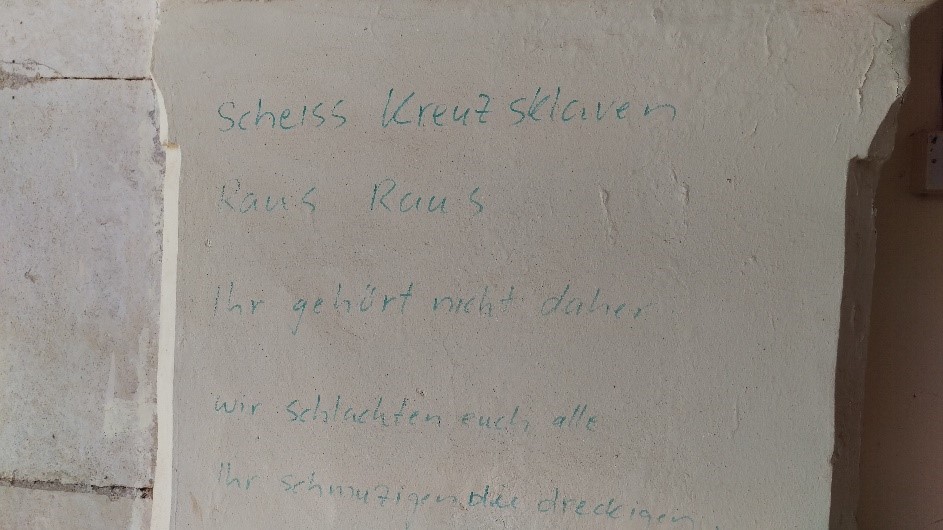
This concentration of foreign terrorists in Batnaya reflects its military importance as the front line of ISIS, which if it collapses, the road to Mosul will be open. This happened when it was recaptured on 20 October 2016 by the Peshmerga forces and with the support of the international coalition, after regaining control of it, these forces headed to Mosul without any resistance.
There were more than 100 ISIS fighters in the town. Around 60 were killed during the fight.
There were bullet marks everywhere in mar Quryaqos church and the altar has been desecrated, a wine-red carpet leading down from where priests conducted services for hundreds of years, was strewn with broken concrete, wood and smashed marble.
Batnaya post ISIS
Although the recapture of Batnaya and the expulsion of ISIS from it took place on 20 October 2016, the first ten families returned to it at the end of May 2019, unlike the rest of the areas in the Nineveh Plain where families began to return by spring 2017.
This in itself reflects the challenges Batnaya faced after ISIS and the difficulties faced by displaced families to return to it.
- The huge destruction of the homes and families’ assets.
- Collapse of basic infrastructure and services.
- Explosives and minefields scattered in and around Batnaya.
- Lack of livelihood sources.
In addition, there are other important challenges:
- Trying to get it seized by Sunni Arabs from Telkeif and Mosul by sowing terror among families of the dangers of returning and breaking their will and desire to return, which may gradually encourage them to sell their houses and land. Removing this horror required a lot of effort, especially by working on the rehabilitation of houses and infrastructure, the removal of mines and the provision of a viable environment in Batnaya, which later encouraged families, starting in May 2019, to return.
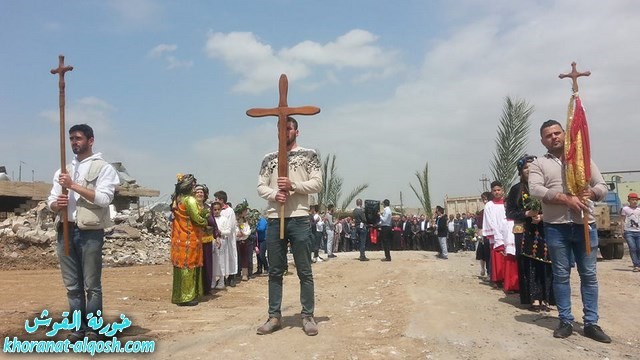
- The security situation and freedom of movement to Batnaya from Telesquf, Alqosh and Dohuk, where Batnaya displaced families live or where their youth and children work or study. Batnaya is under the security control of the central government, and even under the security control of the Popular Mobilization Forces, which runs the check point on the road to Telesquf. With the tensions between the federal government and the Popular Mobilization Forces on the one hand, and the Kurdistan Government and the Peshmerga on the other, especially after the referendum on the independence of Kurdistan in October 2017 and the subsequent military confrontations between the two parties, the families were not encouraging or wanting to move to and from Batnaya due to harassment from the check point and members of the Popular Mobilization Forces. However, with the decline of these tensions, the stabilization of the security situation and the improvement of relations between Erbil and Baghdad, the situation has become normal for movement and communication.
- The social vacuum and psychological pressure on families in Batnaya as it remained a ghost town even after it was re-controlled, and the families’ seeing the rubble and destruction in all of Batnaya and the lack of open community spaces for families, youth and children. This issue has been partially addressed in terms of the number of returning families and the cleaning of roads from rubble (the rubble of destroyed houses is still not cleaned). But there is still a lot to do.

